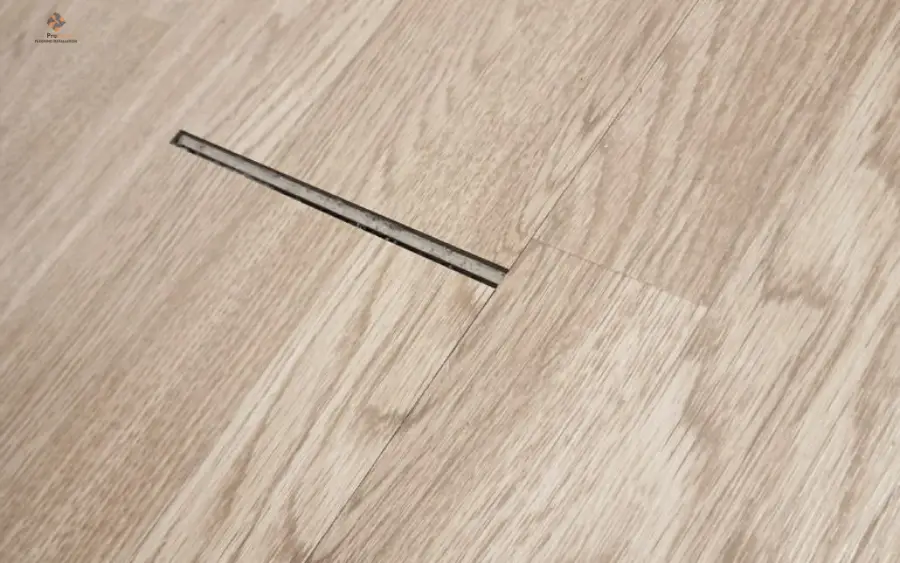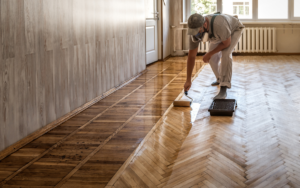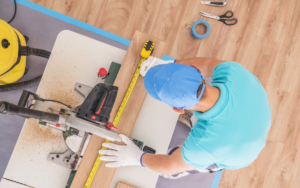How to Fix Wood Floor Gaps and Damage
Common Causes of Wood Floor Separation
- Seasonal humidity changes: Wood naturally expands and contracts with moisture fluctuations. In humid months, floorboards swell, while in drier months, they shrink, causing gaps.
- Poor installation techniques: Incorrectly laid floors can develop gaps over time, especially if improper spacing was left between boards during installation.
- Subfloor issues leading to gaps: A weak or shifting subfloor can create uneven pressure on the wooden flooring, resulting in gaps or separation.
Signs Your Wooden Floor Needs Repair
- Visible gaps between floorboards: This is the most obvious sign of separation and may worsen over time if not addressed.
- Loose or creaking boards: If the boards shift when walked on, or if they squeak, this is a sign that they are no longer properly secured.
- Floorboard cupping or warping: Water damage or prolonged exposure to moisture can cause the edges of the boards to curl upwards, leading to an uneven surface.
Professional vs DIY Wood Floor Repairs
Why Wood Floor Repairs Can Be Tricky
Wood is a natural material that reacts to environmental changes, making it difficult to predict how it will behave during and after repairs. Without experience, you may inadvertently cause more damage by using incorrect materials or techniques.
DIY Floor Gap Filling: Tools and Method
- Wood filler: For small gaps, a wood filler can be used to seal the cracks. It’s important to choose a color that matches the wood grain for a seamless look.
- Rope filler: Thin rope coated in wood glue can be pressed into larger gaps for a rustic fix, but it’s not a long-term solution.
- PVA glue and sawdust: Mixing fine sawdust from the floor with PVA glue creates a custom filler for small cracks.
How Professionals Ensure Durable Floor Repairs
Professional floor installers or repair experts bring in specialized equipment to match the repair method to the type of wood and damage. They can ensure that repairs don’t negatively impact the structural integrity or appearance of your floor.
The Best Methods to Fix Wood Floor Gaps
Using Floor Gap Fillers for Small Cracks
Gap fillers are easy to use for minor cracks between floorboards. These fillers can be found in a variety of colors and can be sanded down to blend with the surrounding wood. They are best for fixing seasonal expansion and contraction gaps.
Replacing Damaged Floorboards for Larger Issues
If the gaps are too large for a simple filler, individual boards may need to be replaced. This involves removing the damaged board, installing a new one, and refinishing the area to match the rest of the floor.
Sanding and Refinishing Wooden Floors
For floors with widespread damage or noticeable wear, sanding and refinishing may be required. This process smooths out surface imperfections and restores the wood to its original look. After sanding, a protective finish is applied to seal the wood and prevent future gaps.
Repair Techniques for Different Types of Wooden Flooring
Fixing Gaps in Solid Hardwood Floors
Solid hardwood floors are prone to seasonal movement, so regular maintenance is key. For significant gaps, professional woodworkers can glue, clamp, and secure boards to restore a seamless surface.
Repairing Engineered Wood Flooring Gaps
Engineered wood is less prone to expansion and contraction, but it can still develop gaps due to improper installation or wear over time. Specialized adhesives and wood shims are often used to secure these floors back in place.
Special Considerations for Laminate Wood Flooring
Laminate wood floors are more sensitive to moisture than solid wood. If gaps develop, a professional may need to remove the surrounding planks and reposition them, ensuring a tight fit.
Preventing Future Wood Floor Separation
Maintaining Proper Indoor Humidity Levels
A consistent indoor humidity level between 30% and 50% can prevent excessive wood expansion or contraction. Humidifiers and dehumidifiers can help maintain this balance, especially during seasonal changes.
The Importance of Regular Wood Floor Maintenance
Routine inspections and cleaning can help identify and address early signs of separation. Floors should be swept regularly to prevent dirt and debris from getting into cracks, which can make gaps worse.
How to Inspect Your Floors for Early Signs of Damage
Look for any small gaps or movement in your floorboards. Early detection of gaps or creaks can help prevent bigger issues, as minor repairs are much easier and cheaper to handle.
Compare DIY vs Professional Services
Hidden Costs of DIY Floor Repairs
While DIY may seem cost-effective at first, improper repairs can lead to further damage down the line. Floorboards may shift or loosen, leading to additional costs in refinishing or replacing larger sections of the floor.
Risks of Improper Wood Floor Repairs
Incorrectly applied fillers can create uneven surfaces, and improperly installed floorboards can make the floor structurally unsound. Without the proper tools and knowledge, DIY efforts can turn into costly mistakes.
Professional Expertise in Avoiding Common Mistakes
Hiring a professional ensures that the repair is done correctly the first time. Experts can address the root cause of floor separation, such as subfloor issues, moisture imbalances, or improper installation, to prevent future problems.
Visit our Home Page for more information.
FAQ
Yes, small gaps can be fixed using wood fillers, but for larger gaps or severe damage, it's best to hire a professional to ensure a long-lasting repair.
Seasonal changes in humidity, improper installation, or issues with the subfloor can cause gaps in wooden floors. A professional can accurately diagnose the issue.
Costs vary depending on the extent of the damage. Minor repairs are affordable, but larger gaps or board replacements may require professional help to avoid future issues.
Professionals use specialized tools to fill gaps, replace damaged boards, and refinish the surface to restore the floor’s original appearance. Their expertise ensures durable results.
Maintaining consistent indoor humidity and performing regular inspections can prevent wood floor gaps. A professional can provide maintenance tips tailored to your floor type.





